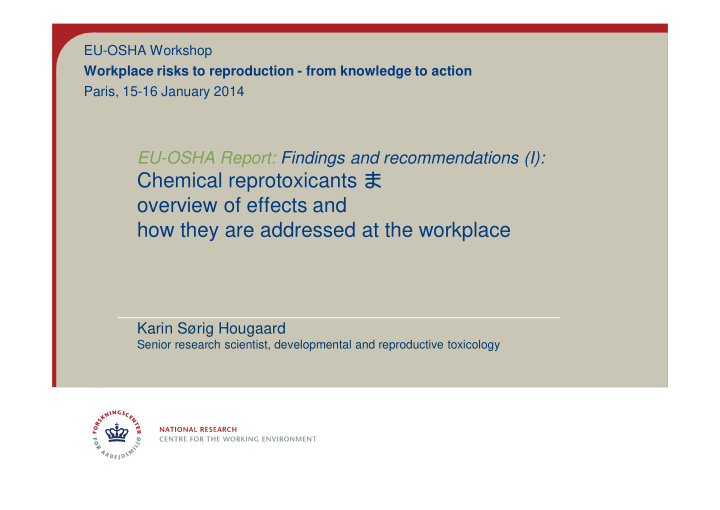



EU-OSHA Workshop Workplace risks to reproduction - from knowledge to action Paris, 15-16 January 2014 EU-OSHA Report: Findings and recommendations (I): Chemical reprotoxicants � overview of effects and how they are addressed at the workplace Karin Sørig Hougaard Senior research scientist, developmental and reproductive toxicology
Discrepancy between number of chemicals in commerce and number evaluated for reprotox of 145.000 chemicals in RTECS have 5% data for reproductive toxicity 95% without data for reproduction
Examples!!! � Particles: Nano- and process generated particles do not trigger testing in REACH � Metals (lead): Much studied � but adequate regulation? � Pharmaceuticals (Anaesthetic gases) Not regulated by REACH � Occupational Exposure Limits � The (pre)pregnancy issue
(nano)Particles and reproduction Maternal blood stream OXIDATIVE TOXICITY STRESS INFLAMMATION OXIDATIVE STRESS INFLAMMATION TiO 2 TiO 2 Neuroendocrine organs? Testicles? Uterus? Ovaries?
TiO 2 Particles � - Regulated as parent material even if Engineered nanoparticles particulates may have different toxicity - Nobody studies effects on reproduction � Process generated particles - Testing not triggered in REACH � Welding particles - Toxic to male fertility???? � Traffic generated (Diesel exhaust particles) - Probable damage to the fetus, but basically unregulated in the work environment (No OELs) - Fertility???? - NO knowledge on particles from Gasoline engines
Metals and metalloids � Many metals studied and classified as toxic to reproduction � Example: LEAD � Ongoing exposure in the work environment � Toxic to male fertility: threshold for effect at 40 µg/dL blood (SCOEL) - EU binding biological limit is 70 µ/dL (lower in some member states) - Newer epidemiology studies indicate effects at much lower levels - This will not trigger initiation of clarifying epidemiology studies, for a chemical where animal models of fertility are of little use - Nor EU reevaluation, although lead is on the candidate list for Annex XIV � Toxic to fetal development - A definite threshold for effects fetal development of the nervous system cannot be derived - Female fertility: studied very little!
Pharmaceuticals: Anesthetic gases Table 9: Dutch recommendations regarding classification of some inhalational anaesthetics with respect to effects on fertility, developmental toxicity and lactation Anaesthetic Recommendation for classification for effects on: Fertility Developmetal toxicity Lactation Isoflurane Lack of appropriate data Lack of appropriate data Lack of appropriate data precludes assessment precludes assessment precludes assessment of classification of classification of classification Enflurane Lack of appropriate data Lack of appropriate data Lack of appropriate data precludes assessment precludes assessment precludes assessment of classification of classification of classification Nitrous oxide Category 3: Substance Category 3: Substance Lack of appropriate data which causes concern which causes concern precludes assessment for human fertility for humans owing to of classification possible developmental toxic effects Halothane Lack of appropriate data Category 3: Substance Lack of appropriate data precludes assessment which causes concern precludes assessment of classification for humans owing to of classification possible developmental toxic effects Source: (Health Council of the Netherlands, 2000a; Health Council of the Netherlands, 2000b; Health Council of the Netherlands, 2002; Health Council of the Netherlands, 2013)
Pharmaceuticals: Anesthetic gases � Dire lack of data regarding reproductive toxicity � Ongoing exposure � Male and female fertility may be affected, and indications of developmental neurotoxicity - No data for lower dose levels � Pharmaceuticals are not regulated by REACH - Come without safety data sheets - Testing not triggered by tonnage � Pharma pre- and clinical data are not available for occupational risk assessment � Most member states have no OELs
Occupational Exposure Limits (OELs) Set limits for exposure via the airborne route such that exposure, even when repeated on a regular basis, throughout working life, will not lead to adverse effects of the health of exposed persons and/or their progeny at any time (as far as can be predicted from the contemporary state of knowledge) European Union: Scientific Committee on Occupational Exposure Limits: Methodology for the derivation of occupational exposure limits
OELs contd. � Limit values should in principle protect the unborn child and future generations �� The absence of relevant data will not normally be a factor in determining the size of an Uncertainty Factor � * � Furthermore, smaller uncertainty factors are generally applied in the occupational setting compared to consumers � BUT - in pregnancy, pregnant women brings with her the fetus to work � Observance of the MAK values does not guarantee � that the unborn child is reliably protected because numerous substances have not yet been investigated or have been only partially tested for prenatal toxicity � (Deutsche Forschungsgemeinschaft, 2006). *European Union: Scientific Committee on Occupational Exposure Limits: Methodology for the derivation of occupational exposure limits
The (pre)pregnancy issue � Most women unaware of pregnancy during the first 4-6 weeks � Fetus might be particularly sensitive early in pregnancy � Some chemicals bioaccumulate or damage germ cells � Exposure might be reversible for adults � but irreversible in fetus Preventive measures enforced at notification of employer of pregnancy (NOT of pregnancy plans) SOLUTIONS Help planned pregnancies � Preconceptional counselling Exclude women from work and money � Preconceptional removal from work site A SAFE CHEMICAL WORK ENVIRONMENT FOR ALL
Recommend
More recommend